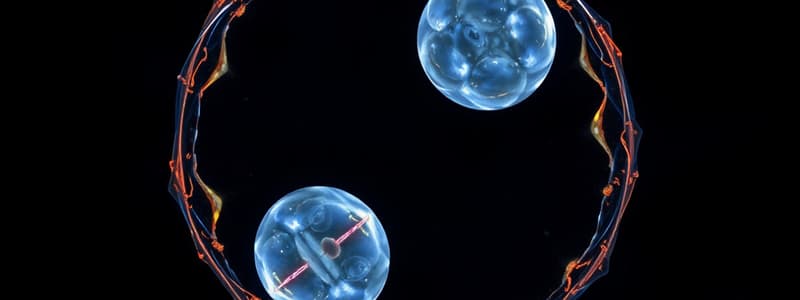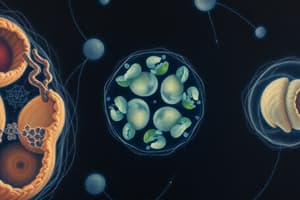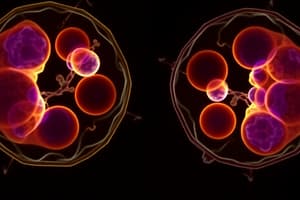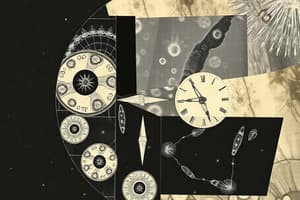Podcast
Questions and Answers
Meiosis II is known as Equitional Division because it is analogous to mitosis, in which the sister ______ are segregated.
Meiosis II is known as Equitional Division because it is analogous to mitosis, in which the sister ______ are segregated.
chromatids
During Prophase I, ______ chromosomes pair by a process called synapsis.
During Prophase I, ______ chromosomes pair by a process called synapsis.
homologous
During Metaphase I, the paired homologous chromosomes align at the ______.
During Metaphase I, the paired homologous chromosomes align at the ______.
metaphase plate
During ______ I, homologous chromosomes separate and move toward opposite poles of the cell.
During ______ I, homologous chromosomes separate and move toward opposite poles of the cell.
Meiosis is the main event involved in the process of gamete formation called ______.
Meiosis is the main event involved in the process of gamete formation called ______.
The average adult male has around 36 ______ cells in their body.
The average adult male has around 36 ______ cells in their body.
Cell cycle is a series of events that takes place in a cell as it grows and ______.
Cell cycle is a series of events that takes place in a cell as it grows and ______.
The division of the cell nucleus is called ______.
The division of the cell nucleus is called ______.
______ is the division of the cytoplasm of the cell.
______ is the division of the cytoplasm of the cell.
During the synthesis phase, the cell makes a copy of the genetic material in the form of nuclear ______.
During the synthesis phase, the cell makes a copy of the genetic material in the form of nuclear ______.
A cell spends most of its time in what is called ______.
A cell spends most of its time in what is called ______.
During the Gap 1 phase, normal ______ functions are carried out inside the cell.
During the Gap 1 phase, normal ______ functions are carried out inside the cell.
A ______ is a control point where stop and go-ahead signals regulate the cell cycle.
A ______ is a control point where stop and go-ahead signals regulate the cell cycle.
The cell cycle is regulated by both internal and ______ regulators.
The cell cycle is regulated by both internal and ______ regulators.
Mitosis is the division of the ______ into two genetically identical nuclei.
Mitosis is the division of the ______ into two genetically identical nuclei.
Prior to mitosis, the DNA replicates, and this is referred to as ______, or the synthesis stage.
Prior to mitosis, the DNA replicates, and this is referred to as ______, or the synthesis stage.
The major event in cell division is the splitting of the nucleus, also known as ______.
The major event in cell division is the splitting of the nucleus, also known as ______.
In early Prophase, ______ move to each pole of the cell.
In early Prophase, ______ move to each pole of the cell.
The period before S phase is referred to as , or ______ stage.
The period before S phase is referred to as , or ______ stage.
______ are formed during prophase.
______ are formed during prophase.
The cell cycle is controlled by a cyclically operating set of molecules which both triggers and coordinates key events, called the cell cycle control ______.
The cell cycle is controlled by a cyclically operating set of molecules which both triggers and coordinates key events, called the cell cycle control ______.
In prophase, the ______ begin to organize spindle fibers.
In prophase, the ______ begin to organize spindle fibers.
During metaphase, chromosomes line up at the center of the cell forming ______
During metaphase, chromosomes line up at the center of the cell forming ______
In early anaphase, sister ______ separate and move toward opposite poles of the cell.
In early anaphase, sister ______ separate and move toward opposite poles of the cell.
In telophase, a new ______ starts to form in each new cell.
In telophase, a new ______ starts to form in each new cell.
Meiosis is a type of cell division used to create reproductive cells, also known as ______.
Meiosis is a type of cell division used to create reproductive cells, also known as ______.
A cell with one set of chromosomes is considered ______.
A cell with one set of chromosomes is considered ______.
A cell with two sets of chromosomes, one from each parent, is considered ______.
A cell with two sets of chromosomes, one from each parent, is considered ______.
Meiosis I is also known as ______ division.
Meiosis I is also known as ______ division.
Flashcards
Meiosis I
Meiosis I
The process where homologous chromosomes separate and move to opposite poles of the cell, creating two haploid daughter cells. This division is characterized by the reduction of chromosome number.
Meiosis II
Meiosis II
The stage of meiosis where sister chromatids separate and move towards opposite poles of the cell, resulting in four haploid daughter cells. This division is similar to mitosis.
Crossing-over
Crossing-over
The process where homologous chromosomes pair up and exchange genetic material, resulting in genetic diversity.
Prophase I
Prophase I
Signup and view all the flashcards
Metaphase I
Metaphase I
Signup and view all the flashcards
S phase
S phase
Signup and view all the flashcards
Cyclins
Cyclins
Signup and view all the flashcards
Regulatory Proteins
Regulatory Proteins
Signup and view all the flashcards
Internal Regulators
Internal Regulators
Signup and view all the flashcards
External Regulators
External Regulators
Signup and view all the flashcards
Mitosis (Karyokinesis)
Mitosis (Karyokinesis)
Signup and view all the flashcards
Cytokinesis
Cytokinesis
Signup and view all the flashcards
Anaphase
Anaphase
Signup and view all the flashcards
Telophase
Telophase
Signup and view all the flashcards
Haploid
Haploid
Signup and view all the flashcards
Diploid
Diploid
Signup and view all the flashcards
Interphase
Interphase
Signup and view all the flashcards
Karyokinesis
Karyokinesis
Signup and view all the flashcards
Gap 1 (G1)
Gap 1 (G1)
Signup and view all the flashcards
Synthesis (S)
Synthesis (S)
Signup and view all the flashcards
Gap 2 (G2)
Gap 2 (G2)
Signup and view all the flashcards
Checkpoints
Checkpoints
Signup and view all the flashcards
Three important checkpoints
Three important checkpoints
Signup and view all the flashcards
Study Notes
The Cell Cycle: Mitosis and Meiosis
- A newborn baby has approximately 26,000,000,000 cells.
- The average adult male has around 36 trillion cells, while females have 28 trillion.
- A cell cycle is a series of events that happen in a cell as it grows and divides.
- The main stages in the cell cycle are interphase and cell division (karyokinesis and cytokinesis).
- Interphase is further divided into gap 1, synthesis, and gap 2.
Interphase (I)
- This is the growth period in the cell cycle and is divided into three parts:
- Gap 1 (G1): The first part of the cell cycle, normal metabolic functions occur inside the cell. Cells increase in size and organelles increase in number during this phase. Cells cannot grow beyond a certain size, even with plenty of nutrients.
- Synthesis (S): The second stage, the cell makes a copy of its nuclear DNA. Copies of chromosomes are made, each containing exact copies of the parent's genetic material.
- Gap 2 (G2): The cell continues normal functions, and grows further in this stage. A critical checkpoint ensures proper transitioning to the next phase.
Checkpoints
- A checkpoint is a control point in the cell cycle where signals determine if the cell can proceed to the next phase or not.
- There are three important checkpoints.
- The first checks if the cell is growing enough and if the DNA is undamaged. If DNA is damaged, it will not replicate and the cell will die.
- The second checks if the DNA is replicated correctly.
- The third checks if the cell has enough resources to continue and if the cell is ready for mitosis.
Mitosis
- Mitosis is the division of the nucleus into two identical nuclei with the same full set of DNA (Karyokinesis).
- It occurs in body cells (somatic cells) except for egg and sperm.
- Mitosis prepares the cell for cytokinesis.
- Mitosis is divided into four phases: Prophase, Metaphase, Anaphase, and Telophase.
Prophase
- In early prophase, centrioles move to opposite cell poles, chromosomes appear as thin threads, the nucleolus becomes less distinct, and the nuclear membrane is visible.
- In mid-prophase, centrioles organize spindle fibers. Sister chromatids form with a centromere at their point of attachment.
- In late prophase, centrioles move to opposite cell poles, the nuclear membrane breaks down, spindle fibers attach to the centromere of each chromosome, and chromosomes move towards the equator, and the nucleolus is gone.
Metaphase
- The nuclear membrane has completely disappeared.
- The centromere of each double-stranded chromosome attaches to a spindle fibril at the cell's center.
- Centrioles are at opposite poles of the cell.
- The chromosomes align at the cell's center forming the metaphase plate.
Anaphase
- In early anaphase, sister chromatids separate and start moving towards opposite poles of the cell.
- In late anaphase, the two sets of new, single-stranded chromosomes migrate towards their respective poles in the cell. Cytokinesis begins (division of cytoplasm).
Telophase
- The new nuclear membrane starts forming in each new cell.
- Chromosomes become longer, thinner, and less distinct.
- The nucleolus reappears.
- Centrioles are replicated. Cytokinesis is nearly complete.
- Spindle fibers and asters disappear. (In plant cells, the primary cell wall or division plate forms a boundary between the two daughter cells.)
- The cleavage furrow deepens and the cells divide into two parts.
Meiosis
- Meiosis is cell division that creates reproductive cells (gametes) like sperm and egg cells, or spores.
- Meiosis produces four haploid daughter cells, which are analogous to mitosis where sister chromatids are segregated with four haploid daughter cells.
- Meiosis is divided into phases:
- Meiosis I (reductional division): Ploidy is reduced from diploid to haploid.
- Prophase I, Metaphase I, Anaphase I, Telophase I
- Meiosis II (equational division): Sister chromatids are separated creating haploid daughters.
- Prophase II, Metaphase II, Anaphase II, Telophase II
- Meiosis I (reductional division): Ploidy is reduced from diploid to haploid.
Ploidy
- Ploidy is the number of chromosome sets in a nucleus.
- There are two prominent types of ploidy:
- Haploid (containing one set of chromosomes).
- Diploid (containing two sets of chromosomes, one from each parent).
Meiosis I - Prophase I
- Chromosomes coil and shorten.
- The nuclear envelope disintegrates.
- Homologous chromosomes pair via a process called synapsis.
- Genetic material may exchange between homologous chromosomes.
Meiosis I - Metaphase I
- Paired homologous chromosomes align at metaphase.
- The chromosomes in pairs are attached to spindle fibers.
Meiosis I - Anaphase I
- Homologous chromosomes move towards opposite poles of the cell.
Meiosis I - Telophase I
- Chromosomes reach opposite poles.
- The nuclear membrane forms; cytokinesis follows.
Meiosis II - Prophase II
- Nuclear membrane disintegrates.
- New spindle fibers form around chromosomes.
Meiosis II - Metaphase II
- Chromosomes align at the metaphase plate; attached to spindle fibers.
Meiosis II - Anaphase II
- Chromosomes divide into two sister chromatids and they move to opposite poles.
Meiosis II - Telophase II
-
Nuclear membrane forms around each set of chromosomes.
-
Spindle fibers disintegrate.
-
Cytokinesis occurs creating four haploid daughter cells.
-
Gamete formation in males is called spermatogenesis and in females is oogenesis.
-
A sperm cell has 23 chromosomes; a human body cell has 46 chromosomes.
-
Sex cells have half the usual number of chromosomes so a fertilized egg receives a normal number of chromosomes.
Studying That Suits You
Use AI to generate personalized quizzes and flashcards to suit your learning preferences.




